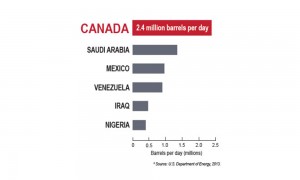Tuesday, President Obama gave remarks at Georgetown University on climate change. He outlined several climate change plans, including comments on the controversial Keystone XL Pipeline. A month prior to his speech, Canadian Prime Minister Stephen Harper visited the US in an effort to build popular support for Canadian energy partnership. This campaign included visits to US institutions and think tanks, and an expansive ad campaign across the metropolitan DC area.
Canada’s public advertising campaign is an example of a traditional public diplomacy advocacy effort, as it seeks to promote specific Canadian policy objectives by presenting an argument. Canada aims to convince American policy makers that its northern neighbor is a better alternative to overseas energy suppliers—not only are they more “environmentally responsible”, but they are also a more secure and stable political alliance. This campaign specifically seeks to frame Canadian energy sources as a national security issue for the United States.
Joao Peixe reported that “The Conservative government has launched a public relations advertising offensive on American lawmakers ahead of Prime Minister Stephen Harper’s trip…selling Canada as an environmental leader in hopes of winning U.S. political support for the Keystone XL oil sands pipeline.”
Canadian supporters of increased oil exports include lawmakers, oil companies and Natural Resources for Canada. The American target audience includes Congress members, White House administration officials and DC area power brokers. As Prime Minister Harper met with the Council on Foreign Relations and other officials in New York, Canadian Natural Resources Minister Joe Oliver met with administration officials in Washington.
The Christian Science monitor reported the campaign was aimed at White House officials in particular, but ads placed elsewhere hint to a broader intended audience. Advertisements for the new Canadian government website were placed in sources such as Politico, The Hill, the Washington Post, The New Republic, CQ Weekly and Roll Call. These publications are usual reads for lobbyists and officials on Capitol Hill, and are clearly meant for opinion leaders.
Additional advertisements were placed on DC Metro area bus stops and metro centers. These ads highlight Canadian and American friendship, emphasizing their relationship as a “model for the world” and their common values of democracy and free markets. Campaign ads effectively frame energy as a national security issue and display Canada as a “reliable source of fuel.” These ads are obviously seen by powerful commuters, who Canada hopes will pressure pipeline friendly legislation.
As the campaign comes to an end, the question of its efficacy arises. President Obama finally spoke about Keystone Tuesday, quickly stating the pipeline would only move forward if it was a carbon neutral project before moving on with other topics. With this phrasing, the administration now must calculate differences between pipeline and rail transport for oil from Alberta, and the effectiveness of Canadian advertising is called into question.
In this case, the goals of this campaign are short term but carry long term implications. It specifically works to frame the pipeline as a matter of national security, but the administration instead focused on environmental implications. While the pipeline is not completely ruled out, the debate now centers around carbon emissions rather than national security needs. As a result, this particular campaign failed in its goal of establishing Canadian oil as a “secure” source for America.




